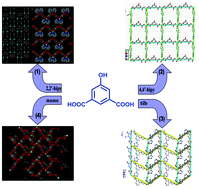Solvothermal reactions of 5-hydroxyisophthalic acid (hip) and different N-containing auxiliary ligands with transition metal salts provided four new metal–organic coordination polymers (MOPs), namely, {Zn(hip)(2,2′-bipy)·2H2O}n (1), {[Ni(hip)(4,4′-bipy)(H2O)]·DMF·2H2O}n (2), {Zn(hip)(tib)·2H2O}n (3), {[Zn2(hip)2]·5H2O}n (4), (2,2′-bipy = 2,2′-bipyridine, 4,4′-bipy = 4,4′-bipyridine, DMF = N,N′-dimethylformamide, tib = 1,3,5-tris(1-imidazolyl)benzene). All of the complexes have been structurally characterized by single-crystal X-ray diffraction analyses, infrared spectra (IR), elemental analyses and powder X-ray diffraction (PXRD). Single crystal X-ray diffraction analysis reveals that complex 1 exhibits a one-dimensional zig-zag chain, in which strong π⋯π interactions are found between neighbouring 2,2′-bipy molecules. Complex 2 has a 2D double-layer square framework, exhibiting AA stacking sequence, and the topology of each layer is typical 2D (44)-sql. In complex 3, both hip and tripodal ligand tib act as bidentate bridging ligand and extend the tetragonal pyramid Zn(II) centers to a 2D wavy framework, exhibiting an AB stacking sequence. The 2D layer structures in 2 and 3 are different from each other. In complex 4, the oxygen atoms of the hydroxy group of hip participate in constructing a framework, which results to the 3D net framework with 1D channel. The structural and topological differences of the four MOPs indicate that the auxiliary ligand play important roles in the formation of final structures. Furthermore, the thermal stability and photoluminescence properties of complexes 1–4 were investigated.


 Please wait while we load your content...
Please wait while we load your content...